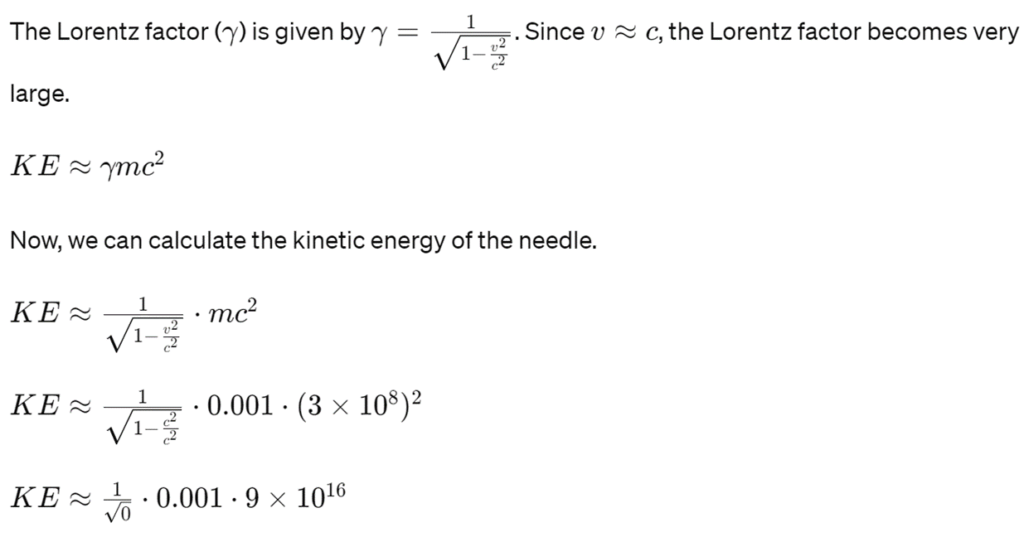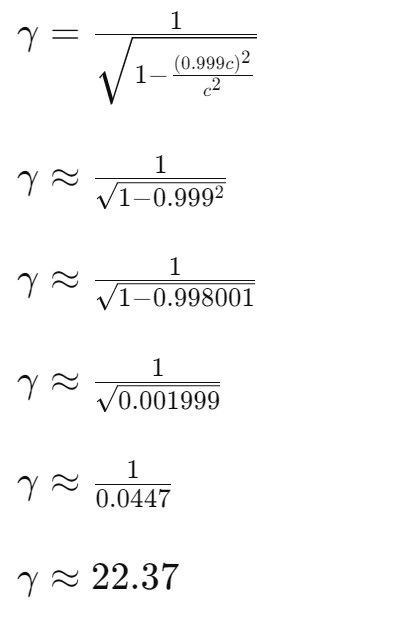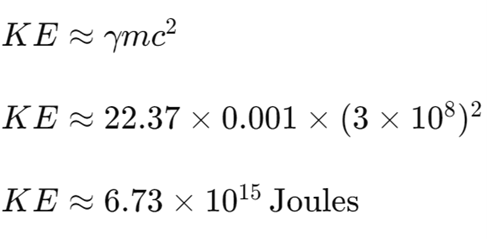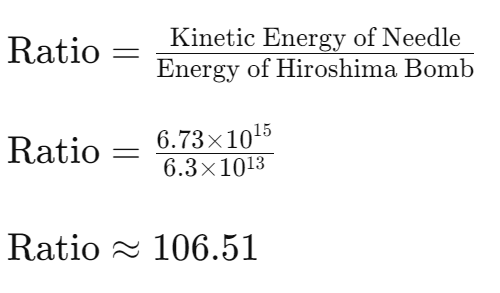
If a tiny needle hit the Earth at light speed, what would happen? It’s a question that people in a bar might ask after several beers, trying to figure out this hypothetical scenario and a rather interesting thought experiment.
And while it’s unlikely (actually impossible) that a needle could ever reach such incredible speeds, the implications of such an event are fascinating.
According to some theories, if a needle were to hit the Earth at the speed of light, the kinetic energy released would be enough to cause an explosion that could potentially wipe out all life on the planet.
The absolute force of impact would be equivalent to a nuclear bomb detonating, and the resulting shockwave would be felt around the world. However, other theories suggest that the needle would simply pass through the Earth, leaving a small hole in its wake.
So let’s try to see all the potential consequences.
Related:
The Concept of Light Speed

The concept of light speed is a fundamental principle in physics that refers to the maximum speed at which any object can travel in the universe. The speed of light is approximately 299,792,458 meters per second (670 616 629 miles per hour), and it is considered to be a universal constant. This means that no object can travel faster than the speed of light.
The theory of relativity, developed by Albert Einstein in 1905, explains the concept of light speed and its implications. According to this theory, as an object approaches the speed of light, its mass increases, and time slows down. This phenomenon is known as time dilation. As a result, it becomes increasingly difficult to accelerate an object as it approaches the speed of light.
In addition to time dilation, the theory of relativity also predicts other strange effects that occur at high speeds. For example, the length of an object in the direction of its motion contracts as it approaches the speed of light. This phenomenon is known as length contraction.
Given the limitations imposed by the concept of light speed, it is impossible for any object with mass to travel at the speed of light. It takes an infinite amount of energy to accelerate an object to the speed of light, which is impossible to achieve.
Therefore, the idea of a needle hitting the Earth at the speed of light is purely hypothetical and impossible in reality.
However, we need to continue with this thought experiment. And for that, we need to define the size and mass of this hypothetical and tiny needle.
The Size and Mass of a Needle

The size of a needle can vary depending on its intended use, but they are generally quite small.
The mass of a needle is also quite small. The mass of a typical sewing needle is around 0.1 grams (0.001 kilogram or 0.035274 ounces). This is a very small amount of mass, especially when compared to the mass of the Earth, which is approximately 5.97 x 10^24 kilograms.
To put this into perspective, consider the following:
- The mass of the Earth is approximately 5.97 x 10^27 times greater than the mass of a typical sewing needle. Basically this is the number: 5970000000000000000000000000!
And while the mass of a needle is rather small, it is still significant when considering the effects of an object hitting the Earth at the speed of light.
Theoretical Physics and Speed of Light Impact

According to theoretical physics, if a needle were to hit the Earth at the speed of light, it would release an enormous amount of kinetic energy. This energy would be powered by the needle’s enhanced relativistic mass and would be released upon contact with the Earth’s surface.
The amount of energy released would be equivalent to a large nuclear explosion, creating massive devastation. However, it is also likely that the needle would vaporize due to friction with air molecules before reaching the Earth’s surface.
However, it is also important to note that the speed of light is incredibly fast and is considered to be the universal speed limit. As mentioned, according to Einstein’s theory of relativity, as an object approaches the speed of light, its mass increases, and time slows down.
Therefore, the needle would have hugely increased mass and would experience time dilation as it approaches the speed of light.
Overall, the impact of a needle hitting the Earth at the speed of light would be catastrophic and would result in widespread destruction.
Having said that, let’s try to apply calculations to find out what would be the exact potential impact in mathematical and physics terms.
Let’s compare it with the atomic bomb dropped on Hiroshima.
Tiny Needle vs Hiroshima Bomb Impact Calculation

First, we need to set up some parameters to compare the Needle with an Atomic bomb:
- Needle Impact at the Speed of Light:
- Mass of the needle, m=1 gram = 0.001 kg
- Speed of light, c≈3 ×108 m/s
- Kinetic energy (KE) can be calculated using the formula KE = 1/2 mv2, where m is mass and v is velocity.
- The relativistic kinetic energy formula, taking into account the effects of special relativity at speeds close to the speed of light can be calculated using the Lorentz factor.
- Hiroshima Bomb Impact:
- The energy released by the Hiroshima bomb is typically measured in terms of TNT equivalent. The “Little Boy” atomic bomb dropped on Hiroshima in 1945 had an estimated yield of about 15 kilotons of TNT, which is equivalent to 6.3×1013 joules.
Ok, now for the calculations:

Since the Lorentz factor is approaching infinity, this calculation becomes problematic. In reality, macroscopic objects (aka. can be seen with naked eye) with mass cannot reach the speed of light due to the principles of relativistic physics.
As an object with mass approaches the speed of light, its relativistic mass increases, requiring an infinite amount of energy to reach the speed of light. This is not achievable with our current understanding of physics and technology.
Nonetheless, we are relentless so we’re continuing with this thought experiment and calculation.
According to the equations of relativity, it would take an infinite amount of energy to accelerate an object with mass to the speed of light. This theoretical limit prevents us from reaching or exceeding the speed of light with macroscopic objects.
However, we can provide a hypothetical calculation for a given velocity that is close to, but less than, the speed of light.
Let’s say the needle is moving at 99.9% of the speed of light (v=0.999c), then we calculate the Lorentz factor like:

Now, let’s calculate the kinetic energy:

And finally, let’s compare this kinetic energy to the energy released by the Hiroshima bomb:

So, the ratio of the kinetic energy of the needle at 99.9% of the speed of light compared to the energy released by the Hiroshima bomb is approximately +106.51!!
Now that’s a really staggering number. A tiny needle releasing 106.51 times more energy than the atomic bomb.
Ok, so since this is a significant amount of energy mixed with impact at unimaginable speed, let’s consider other hypothetical consequences starting from Earth’s atmosphere and craters to the potential seismic activities and much more.
Potential Impact on Earth’s Atmosphere

When a needle hits the Earth at the speed of light, it would cause a tremendous amount of energy to be released. This energy could ignite the atmosphere, causing a chain reaction that would lead to widespread destruction.
The energy released from a needle hitting Earth at light speed would be similar to a large nuclear explosion. This explosion would possibly create a massive fireball, which would consume everything in its path.
The fireball would create a shockwave that would travel outward from the point of impact, causing even more destruction.
The shockwave would be strong enough to knock down buildings and cause widespread damage to infrastructure. The heat from the fireball would also cause widespread fires, which would be difficult to control due to the intensity of the flames.
Shock Waves

Potential shock waves created by the impact of the needle would be felt around the world. The energy released by the impact could cause the ground to shake, and the shock waves would travel through the Earth’s crust, causing earthquakes and other geological events.
The shock waves would also travel through the atmosphere, causing sonic booms that would be heard for miles around.
The impact of the needle would also cause a massive release of radiation, which would have a devastating impact on life on Earth. The radiation would be strong enough to kill most living organisms, and the fallout from the explosion would contaminate the environment for years to come.
Global Climate Impact

If a needle were to hit the Earth at the speed of light, the energy released would be so immense that it could have a significant impact on the global climate.
Here are two potential effects:
Potential for Nuclear Winter
As mentioned, the impact of a needle traveling at the speed of light could be similar to that of a nuclear explosion. The force of the impact would cause a massive shockwave, which could trigger earthquakes and volcanic eruptions.
The dust and debris kicked up by these events could block out the sun’s rays, leading to a “nuclear winter” effect. This could cause a severe drop in global temperatures, leading to crop failures and widespread famine.
Note: We’ve written similarly about “volcanic winter” in our article named “What Would Happen If Yellowstone Erupted.”
Long-Term Climate Change
Even if the impact would not trigger a nuclear winter, it could still have long-term effects on the global climate. The energy released by the impact could cause significant changes in the Earth’s atmosphere, including an increase in greenhouse gas emissions.
This could lead to a rise in global temperatures, which could cause sea levels to rise and lead to more extreme weather events. The impact could also cause changes in ocean currents, which could have far-reaching effects on the global climate.
Survival and Recovery

Impact on Human Life
If a needle were to hit the Earth at the speed of light, the impact on human life would be catastrophic. The explosion resulting from the collision would be equivalent to a large nuclear explosion, causing massive devastation. The energy released would create a shockwave that would travel through the Earth’s surface, causing widespread destruction. The explosion would also generate a massive amount of heat, which would cause fires in the surrounding areas.
The immediate effects of the explosion would be felt over a large area, and the blast wave would cause significant damage to buildings and infrastructure. The heat generated by the explosion would cause fires that would be difficult to extinguish, and the resulting smoke and debris would make it difficult for rescue workers to access affected areas.
In the long term, the ecological impact of the explosion would be rather significant.
Summary

In conclusion, the impact of a needle hitting the Earth at the speed of light would be catastrophic. The energy released by the impact would cause widespread destruction, and the shock waves would be felt around the world. The impact would also cause a massive release of radiation, which would have a devastating impact on life on Earth.
All of that, of course, if such an event could happen. And as we concluded – this hypothetical scenario can not happen. At least not with our current understanding of physics.
However, perhaps some advanced alien civilizations have the resources, technology, and knowledge to create such a tool (flying needle) combined with (for us) unknown laws of physics. Perchance in that case, such a scenario could happen.
Who knows – the universe is full of mysteries.
And that’s why we like different hypothetical scenarios and thought experiments.
Note: If you too like those kinds of articles we’d recommend checking out:
- What If Theia Never Hit The Earth?
- What If Earth Had Rings?
- What If Earth Had Two Moons?
- What would happen if Moon disappeared?
- What Would Happen If Jupiter Disappeared?
- What Would Happen If You Fell Into A Black Hole?
- What Would Happen If The Moon Exploded
- What Would Happen If The Earth Stopped Spinning?



























